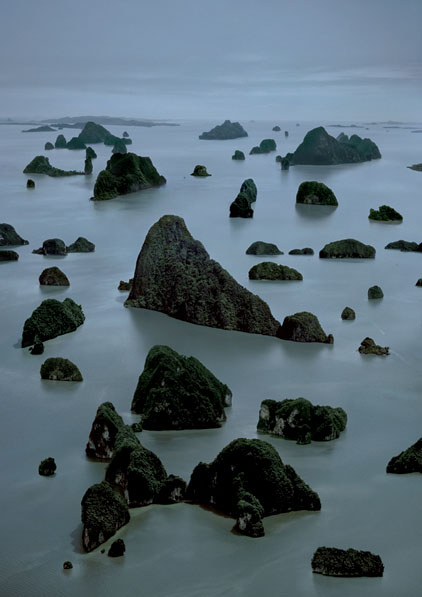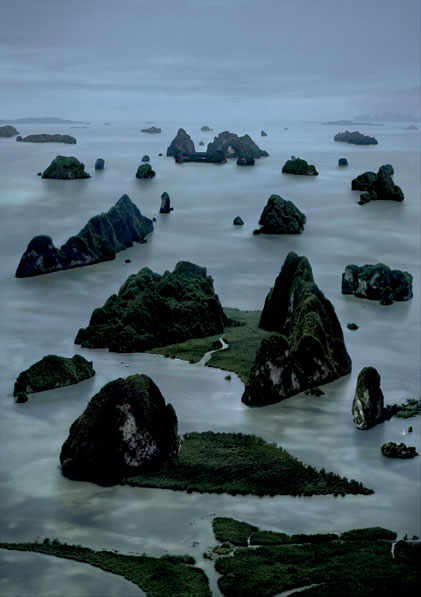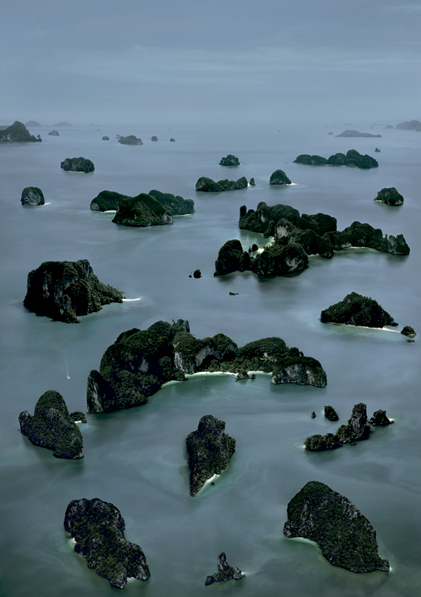
"Pyongyang I," Andreas Gursky, All rights reserved.
My office is just a few blocks from the new Andreas Gursky show at Matthew Marks Gallery, so I won’t say much till I’ve seen it. In the meantime the blog buzz, reviews & reactions to reviews (here, here, here and here) makes great reading. I saw Gursky’s retrospective at MOMA in 2001 and was blown away by his god-like prints – which celebrate the scale & pattern of vast & complex swathes of the world (an entire working container ship port in Italy, say) while managing somehow to include human street shot details that give them life. If Gursky's work in that show was olympian, his god’s-eye view at least had an amused fondness for mortals and their creations.
At the time I had heard Gursky studied with the Bechers, that he later learned techniques perfected in Germany to produce billboards. Also, that he did a lot of post production work. Vaguely, I figured this meant he chose his light carefully, spent a great deal of energy perfectly positioning his view camera, used the swings & tilts & then Photoshop for perspective control, did a lot of correction & cleaning up afterward. I figured he rendered basically what he SAW – just a lot more rigorously than most of us. I guess that was naïve.
Here is an analysis of Gursky's new work by Chris Jones at Perceptual Prostheses:
“… To begin with, he [Gursky] approaches images now, as most photographer artists do, without the constraints of the frame. Images are constructed using various instances or perspectives, assembled into a final frame, but coming from many. This is representative of how in the age of digital new media, the traditional notion of the image has become obsolete. The frame has been exploded, images become programmable.”
Jones goes on to use an aerial perspective of sea islands as an example.
“This image is a composite of many pictures taken of various islands. Some islands appear in the image twice, but from different perspectives. The resulting assemblage has an uncanny balance, because the perspectives are not quite perfect, and our eyes are very attuned to this.”
This is the island he's talking about. (Below it are two variations I added).

"James Bond Island I" , Andreas Gursky, All rights reserved.

"James Bond Island II", Andreas Gursky, All rights reserved.

"James Bond Island III," Andreas Gursky, All rights reserved.
It really doesn’t matter to me how Gursky makes his images. Although I don’t approach my work as Jones claims “most phographer artists do,” I can be inspired by any kind of art. From the JPEGs I’ve seen (the originals are 10 feet high, so the JPEGs are absurd of course), this new work does seem a bit chilly, as though the god I facetiously invoked above had grown weary, detached from his playthings – but I’ll wait to see the originals.
I have to confess though to a certain uneasiness as agenda-setting art seems to get even bigger & bigger, more & more technologically complex – more industrial. Whether it’s a full-sized working replica of a locomotive hanging from a crane (Koons) or Gursky's billboard-sized photographically precise island vistas that never existed, the art seems to be getting further & further away from what most artists can ever dream of doing. Further & further away from earth.
No comments:
Post a Comment